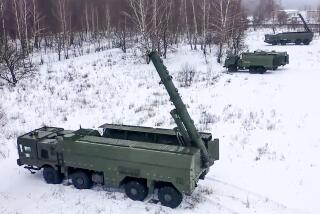Going on the Defensive to Denuclearize Europe
- Share via
CAMBRIDGE, ENGLAND — The Warsaw Pact countries have recently proposed consultations between the North Atlantic Treaty Organization and the Warsaw Pact on how to make their non-nuclear strategies less offensive and more defensive. So far the West seems not to have responded to this novel and potentially most important opening. It is high time it did so.
The background is that if reliance on nuclear weapons in Europe is to be diminished--by agreement on intermediate-range nuclear missiles or by further steps--the problem of NATO’s fear of the Warsaw Pact’s non-nuclear forces must be faced. For NATO acquired nuclear weapons, and adopted its doctrine of “First Use,” in order to offset its perceived inferiority in non-nuclear forces; and fear of that inferiority is still the reason for its reliance on nuclear weapons.
The orthodox approach to the problem is to call for negotiations to reduce or check the level of non-nuclear forces, subject to the caveat--sometimes proclaimed almost as a war-cry--that there must always be a balance between the two sides. Balance is taken to be the precondition of security that must be preserved whether the level of forces in being lowered, raised or kept steady.
There are two fundamental objections to this approach.
The first is that the asymmetries and uncertainties between the geography, men, weapons, morale and every other attribute of the forces of any two nations or alliances are so great that balance can never be measured, let alone agreed, without a high probability of dispute and deadlock. That is the immediate issue on which arms negotiations have broken down repeatedly since the beginning of this century. Moreover the problem of measuring balance will be far more difficult now that non-nuclear forces are so complex and diverse than it was for prewar conventional forces, or is for nuclear weapons, where numbers of warheads, megatonnage and other physical units can be invoked.
The second objection is that it is not balance that brings security so much as whether the forces are designed, equipped and trained with emphasis on the offensive or the defensive. If NATO and the Warsaw Pact had equal and identical non-nuclear forces, but the character of those forces was such that they had strong offensive capabilities and were vulnerable to surprise attack, there could be no security; by attacking, either side could hope to knock out the other at the non-nuclear level. Security would not be achieved by making balanced reductions--or balanced increases--in the size of those forces. With smaller or greater forces there would still be much the same possibility of a successful attack--and the same fear of attack. Those risks derive from the offensive character of the two forces, not their size.
What matters for security is that the doctrine, structure, training and other characteristics of the forces of each side should be such that the ability to take the offensive is minimized, and the ability to defend and hold an attack is maximized. If that strategy were successfully adopted, each side would find that its defensive capability exceeded its opponent’s offensive capability. The military postures of each side would be reassuring, not threatening, and consistent with the peaceful political aims that each side professes.
What this means in Europe is that the Soviet Union and Warsaw Pact should change doctrine away from the notion that the best form of defense is retaliatory attack, and reduce its large tank armies and other features of its non-nuclear forces that frighten NATO, in favor of a more defensive posture. And NATO should eschew those features of its non-nuclear forces that frighten the Warsaw Pact--for example, the planned introduction of high-tech non-nuclear missiles and the systems to control them which the Warsaw Pact countries see as a threat to their command structure and other key targets.
How should a change in strategy in this direction be achieved? It requires that reliance on mobile armored forces with high potential to attack, or counterattack, the armored forces of the other side be reduced in favor of dispersed anti-tank forces, earthworks, mine fields and other less mobile, defensive forces; and that the capacity to attack concentrated forces and other vital targets be reduced, as well as reliance on such “rich” targets.
Traditional negotiation of balanced changes is clearly not appropriate. Apart from the objections to the pursuit of balance already mentioned, the changes required on one side, if it is to reduce offensiveness and increase the defensiveness of its forces, are likely often to be different in character and size from those required on the other side. And by making some kinds of changes independently, one side may preserve or increase its security, even if the other makes no change.
What is needed therefore is a new and more cooperative form of dialogue. Ideas of how to make military postures less offensive and more defensive need to be discussed; each side should tell the other what it fears and should try to meet the fears of the other. Formal agreements would be required when changes needed to be ratified, or in those instances where symmetrical changes really were needed and a change by one side could not be risked without reciprocity. This approach has a considerable following in West Germany, Denmark and the Netherlands, but it has not yet gained official support in NATO.
What is interesting and new is that since Mikhail S. Gorbachev came to power, the Soviet Union and Warsaw Pact have taken up these ideas that originated in the West. Gorbachev has publicly said that the doctrine of their non-nuclear forces must be defensive. The Warsaw Pact countries first declared that to be their position in June, 1986, in Budapest. Then in Berlin at the end of this May, they proposed consultations with NATO at the expert level “with the aim of comparing the military doctrines of both alliances, analyzing their character and jointly studying the directions of their further evolution with a view to removing the suspiciousness and mistrust that have accumulated . . . and ensuring that the military concepts and doctrines of the military blocs and their members be based on defensive principles.”
This is an opening of the greatest interest. Here are the Soviets saying they want to discuss with us how to implement a defensive doctrine that implies that they should scrap their non-nuclear offensive capability; in other words, scrap the threat that, in Western perceptions, lies at the heart of the confrontation in Europe. One can think of plenty of cautions and reservations. It will be as great a challenge for the new Soviet leadership to impose radical new ideas on the military as it is to impose them on the economy; they may fail; it will take time; it might weaken their hold on Eastern Europe. But that in no way weakens the view that this is an opening to be welcomed and taken up in a positive spirit by the West. There is nothing to lose and a great deal to be gained.
More to Read
Sign up for Essential California
The most important California stories and recommendations in your inbox every morning.
You may occasionally receive promotional content from the Los Angeles Times.










